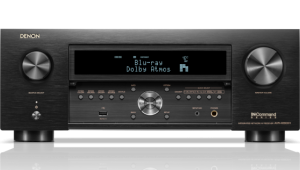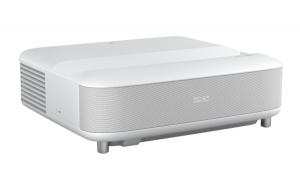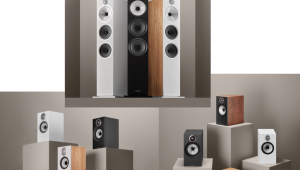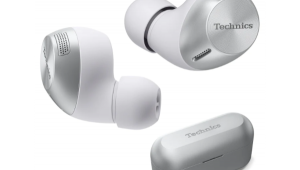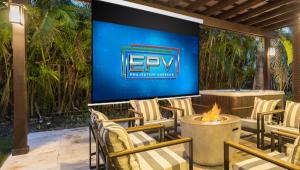Test Report: Yamaha YSP-2200 Digital Sound Projector Page 3
Bottom Line
Yamaha has not quite convinced me that a compact, two-piece solution like the YSP-2200 can replace “real” surround systems in every case, but it has certainly won a convert for situations where space, decoration, or the imperatives of domestic détente make a full system impractical or inadvisable. In fact, the YSP-2200’s going up in the bedroom until Yamaha demands it back. ’Nuff said?
Test Bench
Frequency response
• soundbar 530 Hz to 20 kHz ±8.4 dB, 600 Hz to 10 kHz ±2.7 dB
• subwoofer 41 to 128 Hz ±3 dB
Bass output, subwoofer (CEA-2010 standard)
• Ultra-low bass (20-31.5 Hz) average: NA
20 Hz: NA
25 Hz: NA
31.5 Hz: 82.7 dB
• Low bass (40-63 Hz) average: 104.3 dB
40 Hz: 96.9 dB
50 Hz: 107.3 dB
63 Hz: 108.7 dB
To measure the frequency response of the YSP-2200 soundbar, I placed it atop a 6-foot stand and placed the microphone at a distance of 2 meters, enough to incorporate the contributions of all the drivers. The curve you see here represents an averaged response from 0° to 30°, smoothed to 1/12th of an octave, with Adventure mode activated. I measured the frequency response of the subwoofer using ground plane technique, with the sub on the ground and the mike 1 meter from the front of the sub, and the measurement smoothed to 1/6th of an octave.
The YSP-2200 measures considerably differently depending on which surround mode is employed. I got the flattest response in the Movie modes; for example, the Adventure mode yielded an averaged 0° to 30° response of ±8.4 dB, and an impressive on-axis response of ±2.7 dB all the way out to 19 kHz. In the averaged response, there’s a big 15.1-dB dip centered at 7.7 kHz, but the response from 600 Hz to 6 kHz is admirably smooth for a soundbar. Further off-axis, many small dips and peaks appear at 45° and 60°, but except for a roughly 8-dB treble peak centered near 10 kHz, the response remains fairly flat.
The Music modes add a lot more reverb and digital signal processing than the Movie modes, so some weird things happen in the measurements, but the end result seems okay. In Jazz Club, the most restrained of the Music modes, the on-axis response measured a rather rough ±11.3 dB, but the averaged response measured ±5.1 dB.
In stereo bypass mode, the YSP-2200 is not as smooth as in the DSP modes, at ±11.3 dB averaged response and ±10.9 dB on-axis response.
The obvious downside to these measurements is that the soundbar has no significant response below 500 Hz. This leaves a sonic “hole” between the soundbar and the subwoofer.
Frequency response of the sub measures close to flat between 40 and 120 Hz in Adventure mode. The response varies only slightly with the different DSP modes, in ways that don’t make intuitive sense, at least to me. For example, the Game mode has an almost identical response to Adventure, but it extends the subwoofer’s response out to 160 Hz. The Concert Hall mode has the same response as Adventure, but boosts output by 3 dB. Stereo bypass mode boosts output by +3 dB and extends the response out to 150 Hz. Go figure.
The output of the YSP-2200 subwoofer proved complicated to measure because its latency (the time between receiving the signal and playing it) was about 100 milliseconds. While the latency proved no problem for the Clio FW hardware and software I used for the frequency-response measurements, I wasn’t able to figure out a way to get the software for CEA-2010 subwoofer output measurements to work with such a long delay time.
My solution was to measure the subwoofer powered directly from my Carver A-400x 200-watt-per-channel stereo amp, instead of using the soundbar’s 100-watt internal amp. This doubling of power gave the subwoofer a possible +3 dB advantage in CEA-2010 measurements. However, that’s assuming the amplifier, and not the drivers, is the limiting factor in output; with products like this, I’ve found that the drivers are usually the weakest link. So while my CEA-2010 measurements might be a decibel or two high here, they’re reasonably representative of what you’ll get.
All that said, the bass output was pretty good, averaging 104.3 dB in the low bass (40-63 Hz) and providing measurable output (82.7 dB) at 31.5 Hz. It’s certainly adequate to keep up with the soundbar’s output. — Brent Butterworth
- Log in or register to post comments








